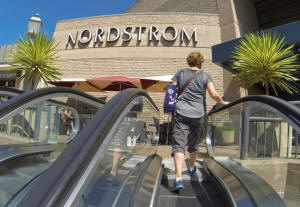|
 Higher
spend on essentials, online bargains hit U.S. department stores Higher
spend on essentials, online bargains hit U.S. department stores
 Send a link to a friend
Send a link to a friend
[November 13, 2015]
By Sruthi Ramakrishnan and Tenzin Pema
(Reuters) - Slumping same-store sales at
upscale U.S. department store operator Nordstrom Inc could point to more
than a glut in retailers' inventories, not just a longer-than-usual
spell of warm weather and fewer spendthrift tourists.
|
|
 Trouble at Nordstrom - seen as head-and-shoulder above rivals such
as Macy's Inc and cheaper retailers including Kohl's Corp in terms
of style, quality and customer service - may indicate a permanent
shift in the way people shop and what they buy, analysts said. Trouble at Nordstrom - seen as head-and-shoulder above rivals such
as Macy's Inc and cheaper retailers including Kohl's Corp in terms
of style, quality and customer service - may indicate a permanent
shift in the way people shop and what they buy, analysts said.
While consumers are shying away from buying discretionary items such
as clothes and cosmetics, they are spending more on electronics,
cars, home goods and travel.
Amazon.com Inc has also revolutionized shopping habits, conditioning
shoppers to expect deeper discounts than brick-and-mortar stores can
afford. Analysts call this the "Amazon effect."
"The confusing disconnect between the seemingly strong health of the
high-end U.S. consumer on paper and actual retailer results is much
more a reflection of the tectonic shifts across the retail
landscape," Evercore analysts said in a note.
 This is related purely to the impact of the digital revolution - the
decline of impulse purchases, increased specialization, and the
"shift from things to experiences," they said.
Nordstrom followed Macy's on Thursday in reporting same-store sales
well below Wall Street expectations and cutting its full-year
forecast.
Nordstrom shares were set to open 20 percent lower on Friday.
CAUTIONARY TALE
While some analysts said Nordstrom is well positioned in the longer
term, some took a graver stand.
"With a superior business model, in our view, that is half high-end
department store, 30 percent off-price, and 20 percent online, this
level of deceleration is a potential cautionary tale of the U.S.
consumer's health," Deutsche Bank analyst Paul Trussell said about
Nordstrom.
Trussell cut his price target by as much as $23 to $45, as did
Barclays analyst Joan Payson.
The Commerce Department said last month that U.S. consumer spending
edged up 0.1 percent in September, the smallest gain in eight
months. Consumer spending accounts for more than two-thirds of U.S.
economic activity.
[to top of second column] |

Nordstrom said on Thursday that same-store sales in the three months
ended October grew 0.9 percent, breaking a six-quarter streak of
mid-single-digit percentage growth.
Six brokerages cut their price targets on Nordstrom's stock. The
median price target on the stock is $74, down from $82 a month ago.
Of 30 analysts covering the stock, 11 have "buy" or higher ratings
and 16 rate the stock "hold."
Smaller rival Kohl's surprised on Thursday with a profit and sales
beat, helped by strong back-to-school sales, but several analysts
said the company's turnaround initiatives - smaller shops and
sprucing up stores and merchandise - would not be enough to offset
the sector-wide slowdown.
J.C. Penney Co Inc is scheduled to report results later on Friday
morning. The company gave a sneak preview of its same-store sales on
Wednesday - a rise of 6.4 percent - the best among the retailers
that have reported results so far.
(Reporting by Sruthi Ramakrishnan and Tenzin Pema in Bengaluru;
Writing by Sayantani Ghosh; Editing by Kirti Pandey)
[© 2015 Thomson Reuters. All rights
reserved.]
Copyright 2015 Reuters. All rights reserved. This material may not be published,
broadcast, rewritten or redistributed.
 |